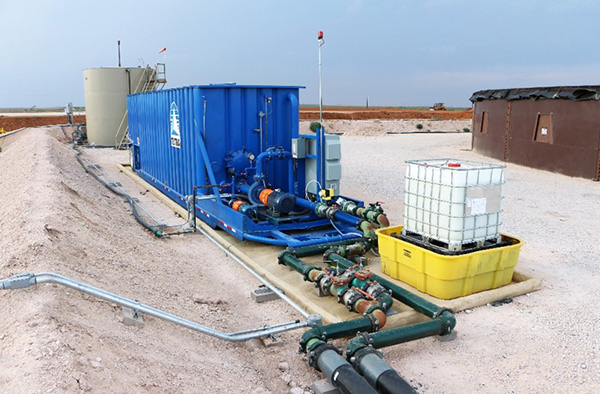Oil Recovery from Produced Water
By Yannick Harvey | Engineering Manager, Water Management | May 29th, 2024

The Challenges of Residual Oil
Practically all produced water contains varying levels of residual oil depending on the reservoir and the specific parameters of the operation. This residual oil poses a number of challenges for recycling and reusing the water for subsequent fracking operations.
First, produced water intended for recycling and reuse must be aggregated in large storage facilities such as pits, above-ground storage tanks, or frac tanks where the suspended oil will separate naturally. The permitting for such storage, however, does not account for the appreciable volumes of oil that can accumulate, leading to regulatory compliance infractions.
Second, the maintenance of these storage facilities—specifically, removing the oil and sludge—is labor-intensive, time-consuming, and expensive.
Third, accumulated oils in storage facilities give off flammable flumes that pose health, safety, and environmental hazards. In some cases, these hazards can even warrant shutting down wellsite operations, a situation that isn’t going to earn any blue ribbons for cashflow.
Fourth, if the residual oil is not removed from the produced water in a timely fashion, the recycling regimen may require additional treatment to achieve adequate quality, such as the addition of an excessive amount of oxidizer.
Oil Recovery Before Water Treatment
As with the timeless expression “When life gives you lemons, make lemonade,” the residual oil in produced water is not an absolute negative. In fact, the operators of commercial saltwater disposal wells consider the ‘skim oil’ an integral revenue stream. So, if you intend to recycle produced water, removing the residual oil well ahead of storage is not only a necessity, it’s also an economic benefit.
To do that, engineers at TETRA conceived and developed the Oil Recovery After Production Technology (ORAPT). The separation system accumulates and removes native residual oil, undesired light constituents, and oil slugs (due to unplanned bypasses) from produced water in real time. The system is designed to facilitate efficient water treatment and compliance with regulatory storage requirements. With the captured oil then diverted to a nearby tank, the water storage remains clean.

The Nuts, Bolts, and Numbers
The ORAPT system works by providing a wide spot in the produced-water line to allow gravity to induce oil separation. The produced water stream is funneled into the main section of a tank where its velocity is reduced, thereby enabling the suspended oil to float to the surface. When the flow reaches the opposite end of the tank, a series of weirs allows the water to be pumped out to the water management system while the oil is diverted to a separate tank.
How efficient is the ORAPT? An absolute efficiency metric is difficult to obtain due to the huge variance in produced water composition from one formation to the next, as well as the different specifications of each job. That said, when operated within its design parameters the technology generally provides an efficiency in the range of 90+% with only trace amounts of oil remaining at 50–100 ppm. Nominal throughput of the system is up to 28,000 barrels of fluid per day.
Among the system features are:
- automated operation;
- self-contained water and oil pump skid for simplified deployment;
- self-contained discharge pumps for chemical injection;
- automated tank-level management, trending, and alarms;
- and automated emergency bypass and shutdown available per operational requirements.
Case Study
In South Texas, the TETRA ORAPT was deployed in the Eagle Ford Shale Play in tandem with the TETRA SwiftWater Automated Treatment (SWAT) system after a major operator had approached TETRA seeking a means to recycle the high volumes of produced water and flowback from an unconventional pad site. At the time, disposal of the site’s wastewater required 50 truck loads per day traveling to and from the remote job site. For the operator, disposal of such high volumes of wastewater was simply not an attractive, long-term solution from an environmental and economic perspective.
One of the challenges with the job was achieving the high standards of water quality set out by the Texas Railroad Commission (TRRC), which regulates the oil and gas industry in the state.
After four months of operation, the SWAT system had recycled 221,360 barrels of water—achieving TRRC standards—and the ORAPT system captured approximately 700 barrels of oil. Additionally, the operation reduced offsite disposal loads from 50 trucks per day to just one.
The operator has been very pleased with the results and plans to continue the recycling and oil recovery operation for at least a full year with subsequent jobs planned.


